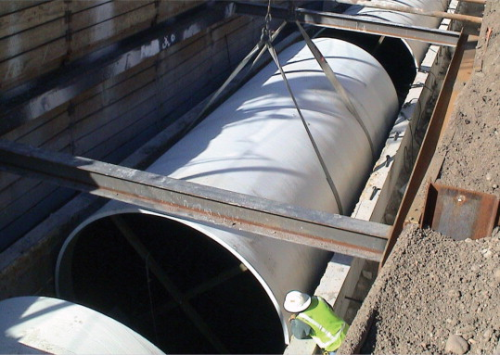
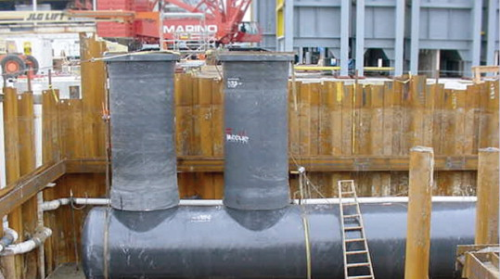
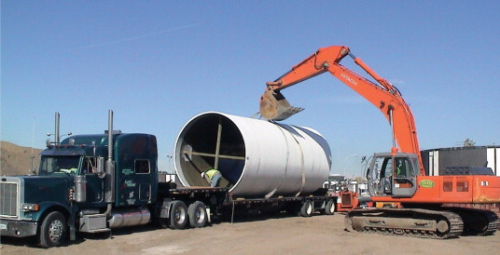
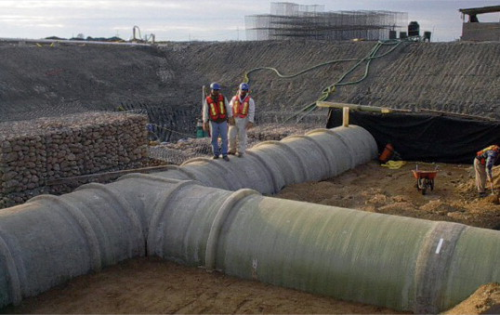
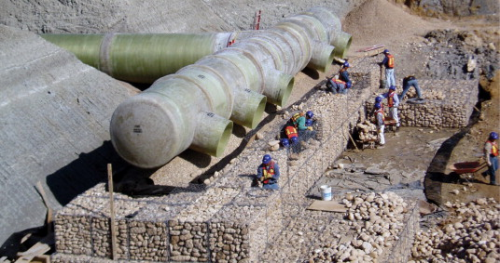
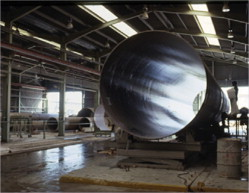
While not as stylish as powerboats and sports cars and often buried and out of sight, fibre reinforced polymer (FRP) composite large diameter pipe has little to show in the way of glamour. But that doesn’t keep the functional and durable composite application from providing steady growth for pipe manufacturers and their raw material suppliers.
The global large diameter pipe industry has been getting stronger in response to market changes that started in the 1990s. And in spite of rising material costs that can be traced to record high crude oil and natural gas pricing, composite pipe remains competitive. The sector is gaining market share at the expense of pipe made with commodity materials such as iron and concrete.
Definition and end-use markets
The term 'large diameter' is generally used to define pipe that is at least 300 mm (12 inch) in diameter. At the higher end, the sector includes composite pipe in diameters as large as 4000 mm (13 ft, 4 inch).
FRP composite pipe is also referred to as GRP, for glass reinforced plastic, because the majority of the manufactured products are reinforced with glass fibres.
New power plant construction is creating opportunities for large diameter pipe in cooling water recirculation systems. The cooling water system of a 1186 MW generating facility in Linden, New Jersey, USA, uses 610 m (2000 ft) of composite pipe. A unit of Beetle Plastics, Ardmore, Oklahoma, USA, manufactured the pipe and fittings in diameters up to 1830 mm (72 inch) using Vipel® F737 isophthalic polyester resin. The operating temperature of the system runs as high as 63°C (around 145°F). Composite was specified for its ability to resist constant exposure to the warm, aqueous environment. In addition, the composite pipe offered a lower mass versus either steel or concrete to reduce shipping and installation costs. Longer lengths made possible with composites also lowered costs by reducing the number of installation steps. |
The resins used are typically unsaturated polyesters, including vinyl esters where higher mechanical, heat and/or corrosion-resistant properties are required.
The majority of large diameter composite pipe is used in six market segments:
- drinking water projects such as raw water supply lines for potable water systems;
- irrigation systems for agriculture;
- feed lines and penstock for hydroelectric power plants;
- circulation for cooling water systems, primarily for power plants;
- sanitary sewer projects for pressure as well as gravity sewer systems, and
- pipeline rehabilitation as 'slip liners.'
Within these market segments, composite pipe has a market share of about 15-20%. Pressure pipes that operate in the range of 6-32 bar account for about 60% of the total composite pipe supply.
The marketing nature of the composite large diameter pipe industry has changed dramatically over the last 15 years. In the past, large diameter composite pipe was considered a speciality product best suited for extreme, corrosive environments. As a result, the largest individual market segment globally has traditionally been sewer pipes.
Paradigm shift
A key factor in the decision to specify composite for sewer applications is the material's ability to withstand corrosive attack from aggressive sulphuric acid. However, specification of composite is expanding beyond the material's speciality roots. Today's engineering community is starting to look at composite pipe as more of a standard material of construction that can be used for general-purpose as well as speciality applications. Composite pipe has become popular in both gravity and pressure pipe applications.
The proliferation of large diameter sewer pipe applications in North America took a dramatic turn in 2006. That's when the Metro Wastewater Reclamation District for the area around Denver, Colorado, USA, installed 152 m (500 ft) of large diameter composite pipe. Belco Manufacturing Company, Belton, Texas, USA, made the pipe using corrosion-resistant Vipel® F010 bisphenol A epoxy vinyl ester resin from AOC. With an inside diameter of 3400 mm (11 ft, 2 inch), the pipe is reported to be the largest composite sewer pipe in North America. The pipe is engineered to resist the sulphuric acid that was eating away the ceiling of a concrete culvert that was installed in 1977. In a unique design solution, engineers decided to retain the bottom portion of original box culvert to serve as a trench for the new composite pipeline. The lightweight and longer lengths of composite piping shortened installation time versus alternative solutions. |
Composite pipe is emerging as a more standard material during a period of rising raw material costs for manufacturers around the world. The cost of pig iron and steel used to make competitive large diameter pipe has increased even more than has been the case for composite raw materials. Composite pipe has increased market penetration, taking share mostly from ductile iron and steel pipes.
Proven durability
Another reason for the increased market share is the fact that FRP pipes for the last 30 years have proven to be a reliable alternative. More than 60 000 km (37 280 miles) of composite large diameter pipe are in operation worldwide to prove that the material will perform long-term as predicted.
The road to today's favourable marketplace for large diameter composite pipe was not always smooth. The composite pipe segment was especially challenged in the 1970s. Lower cost was affecting the specification process at the expense, so to speak, of performance. As a result, some composite pipe being sold into the marketplace developed issues related to deflection and strain corrosion. In some installations, the effectiveness of pipe joints was also coming into question. The negative stories that engineers, specifiers and owners were reading were seen to have a greater influence on decisions than success stories.
In Altamira, Mexico, large diameter composite pipe is helping to turn cryogenic liquefied natural gas (LNG) back into a gas that can be burned in power stations. Corrosion-resistant components for the highly engineered re-gasification system were manufactured of FRP composite by Plasticos Industriales de Tampico SA de CV (PITSA). Composite applications in the Altamira project included: 1830 mm (72 inch) diameter underground water pipe, diffuser and condensator pipe; 660 mm (26 inch) diameter risers; and elbows and other connectors. The structural laminate for the composite parts was made with Vipel® isophthalic polyester resin from AOC. The seawater carried by the intake pipe is the heat source for the re-gasification system. When a heat exchanger panel radiates heat that started with the seawater, the LNG is converted from a cryogenic liquid into an ambient temperature gas. Design temperature for the intake pipe is 35°C (95°F) and internal operating pressure is 5.4 bar (80 psi). Fabrication of strategically located exterior ribs helps the pipe withstand loads from soil, traffic, rocks and changing tides. |
To rebuild confidence in composites, the composite industry redoubled its commitment to establishing standards that ensure the material will live up to its potential. The success that large diameter pipe is enjoying today can be traced to the countless hours of tests, engineering studies and meetings by a small corps of industry advocates devoted to standards-setting. The establishment of effective standards gave specifying influences a reason to pursue composites with more confidence. North American standards that have been especially helpful to the growth of large diameter composite pipe are:
- AWWA (American Water Works Association) C950: Fiberglass Pressure Pipe;
- AWWA M45: Fiberglass Pipe Design Manual;
- ASTM C581: Standard Practice for Determining Chemical Resistance of Thermosetting Resins Used in Glass-Fiber-Reinforced Structures;
- ASTM C582: Standard Test Method for Contact-Molded Reinforced Thermosetting Plastic (RTP) Laminates for Corrosion-Resistant Service;
- ASTM D2992 Standard Practice for Obtaining Hydrostatic or Pressure Design Basis for “Fiberglass” (Glass-Fiber-Reinforced Thermosetting-Resin) Pipe and Fittings;
- ASTM D2996 Standard Specification for Filament-Wound “Fiberglass” (Glass-Fiber-Reinforced Thermosetting-Resin) Pipe; and
- ASME/ANSI RTP-1: Reinforced Corrosion-Resistant Equipment.
This extensive body of work has a major impact on consultants and owners in search of large diameter pipe. Professional standards encourage engineers to specify with confidence. It is important to note that the International Organisation for Standardisation (ISO) and the European Union (EU) have also issued standards on the use of FRP pipe for sewer and water applications.
Major pipe producers
Major producers who focus on large diameter composite pipe mainly for water and sewer applications are experiencing favourable growth. Saudi Arabian Amiantit Company is the largest producer of such FRP pipes in the world today. The company was established in 1968 in the Kingdom of Saudi Arabia to manufacture pipes for the local market. Since then, Amiantit has grown and developed into a major diversified industrial group with operations spanning the globe.
While still mostly a regional producer in the early 1980s, Amiantit manufactured approximately 27 km (17 miles) of large diameter composite pipe to serve major desalination plants in Yanbu and Al-Jubail, Saudi Arabia. Desalination plants are essential components in the Saudi government's plan to diversify the economy. The pipe was manufactured using a Vipel® flexibilised isophthalic polyester resin. The desalination systems in Yanbu and Al-Jubail use both above-ground and buried pipe and fittings for seawater intake, cooling water networks and discharge lines. Pipe diameters range from 350-3700 mm (14-144 inch). The pipe conveys seawater as warm as 65°C (150°F). Portions of the system operate at pressures up to 10 bar (150 psi). Composite components in both underground and above-ground sections are in very good condition after decades of use. |
In 2001, Amiantit purchased the Engineered Pipe Systems unit of Owens Corning, Toledo, Ohio, USA. Amiantit had been a business and joint venture partner with Owens Corning since 1977. The sale included two legal entities based in Norway. One was Flowtite Technology AS, the creator, owner and licensor of the fibreglass pipe technology. The other was Flowtite AS, the shareholder of pipe manufacturing interests in countries around the world.
Amiantit uses Flowtite continuous filament winding technology to make large diameter pipe from plants in 18 countries around the world. During 2007, the group supplied nearly 3000 km (1860 miles) of large diameter FRP pipe with a sales value of US$600 million. Amiantit reports market increases of around 20% per year over the last three years. Market research indicates that this trend should continue for the next four to five years. As a result, the company is planning to add new production lines.
With headquarters in Klagenfurt, Austria, the HOBAS Group is the second largest producer of large diameter FRP pipes in the world. It uses centrifugal casting as its production method. The focus for HOBAS has been mostly in gravity sewer and low pressure applications. HOBAS operates plants in seven countries. For 2007, HOBAS reported a record sales year with turnover of €200 million, an 11% increase over 2006.
Other producers
Other groups participating in the large diameter FRP pipe market are:
- Future Pipe Industries, with plants in Dubai, Qatar, Egypt and Lebanon. The company manufactures using the continuous filament winding process.
- SEKISUI Chemical of Japan has developed its own continuous winding FRP pipe technology suited for the Japanese market. In recent years, it has also been very active in China, where it purchased several plants for manufacturing of helically-wound FRP pipes. These plants were initially delivered by Sarplast of Italy.
- Farassan in Iran has five large diameter pipe production lines with continuous winding machines.
- SUPERLIT of Turkey is operating two pipe production lines in that country.
- Sarplast of Italy markets pipe primarily in Italy and in North Africa, mainly Libya
Expanded production
Large diameter FRP piping is experiencing favourable growth, with applications for water growing the fastest. The proven durability of composite in sewer applications will continue to influence specification of composite pipe in that sector. Pipe opportunities benefit from the continual review and upgrading of performance standards. Installation of composite pipe improves as veteran installers gain experience and all installers benefit from enhanced training. All these factors have specifiers of large diameter pipe turning to composites to get a product that is truly engineered for long-term performance. Participants in the large diameter composite pipe industry are responding by building new production facilities around the world.






